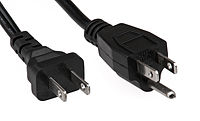
Photo from wikipedia
Existing extension–twist coupling in composite tubes can result in undesirable deformations, which may in turn interfere with their normal performance. In this work, a quantitative factor was developed to examine… Click to show full abstract
Existing extension–twist coupling in composite tubes can result in undesirable deformations, which may in turn interfere with their normal performance. In this work, a quantitative factor was developed to examine the existence of such coupling in circular composite tubes using the non-classical composite beam theory. The theoretical formulation considered transverse shear and three-dimensional (3D) elastic effects in laminated walls. Therefore, the coupling factor can be used in both thin-walled and thick-walled composite tubes. The numerical values for the coupling factor calculated using the present approach were compared to those obtained from a 3D validated finite element model on 10 composite tubes with different stacking sequences. The findings suggested that the coupling factor could accurately detect existing coupling between extension and twist in composite tubes regardless of their stacking sequence. The paper also proposed a number of design guidelines that could be used in order to eliminate the extension–twist coupling in composite tubes.
Journal Title: Journal of Composite Materials
Year Published: 2017
Link to full text (if available)
Share on Social Media: Sign Up to like & get
recommendations!